
Anthocharis midea, the falcate orangetip, is a North American butterfly that was described in 1809 by Jacob Hübner. It belongs to the family Pieridae, which is the white and sulphurs. These butterflies are mostly seen in the eastern United States, and in Texas and Oklahoma. They eat the nectar of violets and mustards. They tend to live in open, wet woods along waterways, in open swamps, and less often in dry woods and ridgetops. This species is a true springtime butterfly, being on the wing from April to May.

The great purple hairstreak, also called the great blue hairstreak, is a common gossamer-winged butterfly species in parts of the United States. It is actually a Neotropical species; its North American range only includes the warm-temperate and subtropical parts of that continent, and it ranges southwards almost to the Isthmus of Panama. The type specimen, however, was shipped to Europe from the Colony of Virginia, probably around the time of the United States Declaration of Independence.

Battus philenor, the pipevine swallowtail or blue swallowtail, is a swallowtail butterfly found in North America and Central America. This butterfly is black with iridescent-blue hindwings. They are found in many different habitats, but are most commonly found in forests. Caterpillars are often black or red, and feed on compatible plants of the genus Aristolochia. They are known for sequestering acids from the plants they feed on in order to defend themselves from predators by being poisonous when consumed. The adults feed on the nectar of a variety of flowers. Some species of Aristolochia are toxic to the larvae, typically tropical varieties. While enthusiasts have led citizen efforts to conserve pipevine swallowtails in their neighborhoods on the West coast, the butterfly has not been the subject of a formal program in conservation or protected in legislation. The butterfly is however of "Special Concern" in Michigan, which is on the Northern limit of its range.

Eumaeus atala, also known as the Atala butterfly or coontie hairstreak, is a small colorful butterfly in the family Lycaenidae. It is found in southeastern Florida in the United States, Cuba, the Bahamas, and the Cayman Islands in the West Indies. Its coloration and habits are unique among butterflies within its range.

The eastern tailed-blue or eastern tailed blue, also known as Everes comyntas, is a common butterfly of eastern North America. It is a small butterfly that is distinguished from other blues in its range by the small thin tail.

Glaucopsyche, commonly called blues, is a Holarctic genus of butterfly in the family Lycaenidae, found mainly in Palearctic Asia. For other species called "blues" see subfamily Polyommatinae and genus Plebejus.

Zerene cesonia, the southern dogface, is a North and South American butterfly in the family Pieridae, subfamily Coliadinae.
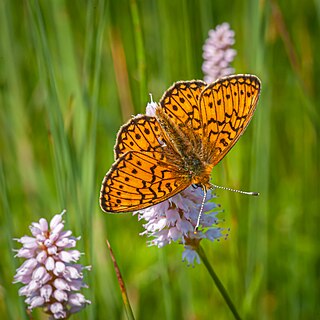
Boloria eunomia, the bog fritillary or ocellate bog fritillary is a butterfly of the family Nymphalidae.

Lycaena epixanthe, also known as the bog copper or cranberry-bog copper, is a North American species of butterfly in the family Lycaenidae. Adults like to sip drops of dew clinging to leaves and almost exclusively nectar on their host plant, cranberries. Because of this, bog coppers will spend their entire lives within the area of a single acid bog. Even though their flight is weak and close to the ground, bog coppers are hard to catch because of the habitat in which they live. Also, 85% of the bog coppers life span is spent in the egg. It is listed as a species of special concern in the US state of Connecticut.

Glaucopsyche lygdamus, the silvery blue, is a small butterfly native to North America.

Lupinus argenteus is a species of lupine known by the common name silvery lupine. It is native to much of western North America from the southwestern Canadian provinces to the southwestern and midwestern United States, where it grows in several types of habitats, including sagebrush, grassland, and forests.
Lupinus elatus is a species of lupine known by the common name tall silky lupine. It is endemic to California, where it is known from the Transverse Ranges above Los Angeles, and possibly also from the southernmost slopes of the Sierra Nevada. Its habitat includes dry areas in the forests of the mountains. This is an erect perennial herb reaching a maximum height near 90 centimeters. Each palmate leaf is made up of 6 to 8 leaflets up to 8 centimeters long. The herbage is coated in silvery silky to woolly hairs. The inflorescence is a long raceme of flowers, each about a centimeter long and arranged in whorls. The flower is purple or blue with a pale yellow patch on its banner. It yields a legume pod 2 or 3 centimeters long. This is a host plant to the Southern California native butterfly subspecies known as the San Gabriel Mountains Arrowhead Blue.
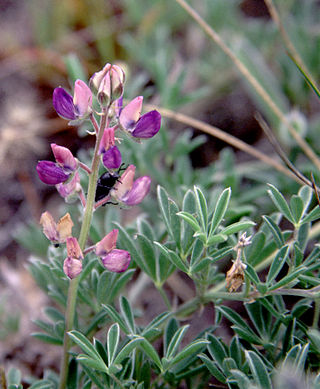
Lupinus littoralis is a species of lupine known by the common name seashore lupine. It is native to the coastline of western North America from British Columbia to northern California, where it grows in sandy habitat.

Cercyonis sthenele, the Great Basin wood-nymph, is a North American butterfly in the family Nymphalidae.

Boloria alberta, the Alberta fritillary, is a butterfly of the family Nymphalidae. It is found in the North American Rocky Mountains of British Columbia and Alberta and in northern Montana.

Euphilotes rita, the rita blue or desert buckwheat blue, is a species of butterfly of the family Lycaenidae. It is found in Wyoming, Colorado, Arizona, New Mexico and northern Mexico. The species was first described by William Barnes and James Halliday McDunnough in 1916.
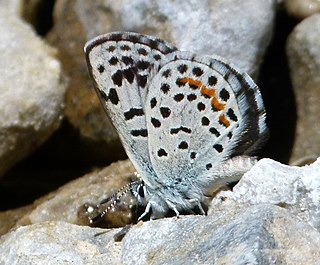
Euphilotes ancilla, the Rocky Mountain dotted blue, is a species of butterfly of the family Lycaenidae. It is found from Washington south to California and southern Alberta and Saskatchewan south through the Rockies and high plains to Wyoming, Colorado, Utah, and northwestern New Mexico. The species was first described by William Barnes and James Halliday McDunnough in 1918.

Lycaena rubidus, the ruddy copper, is a butterfly of the family Lycaenidae. It is found in the western mountains of North America. Adults lay their eggs on plants of the genus Rumex, which later become the larval food plants. This butterfly gets its name from the brightly colored wings of the males, which are important in sexual selection. Its larvae exhibit mutualism with red ants, and are often raised in ant nests until they reach adulthood. Adults are on wing from mid-July to early August.
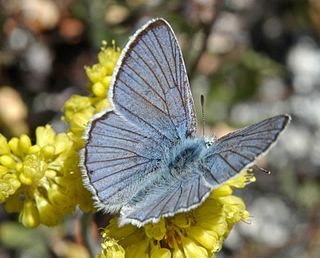
Lycaena heteronea, the blue copper, is an American butterfly that belongs to the gossamer-winged family. The butterfly is named so because of the bright blue hue of the upper side of the males' wings. Females are brown on their upper side. Both sexes are white with black spots on the underside of the wings. Blue coppers are seen on the west coast of the United States and the southwest region of Canada, particularly British Columbia and Alberta. The males are often confused with Boisduval’s blue, another species of butterfly. Blue coppers prefer to live in areas where species of Eriogonum are found. Blue copper larvae sometimes form mutualistic associations with Formica francoeuri, an ant species.
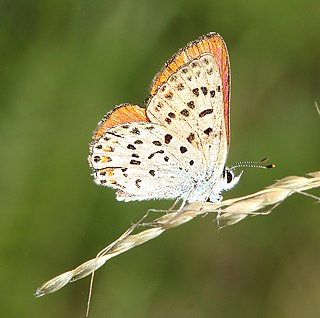
Lycaena gorgon, known generally as the gorgon copper or stream water-crowfoot, is a species of copper in the butterfly family Lycaenidae. It is found in North America, mainly in California.





















